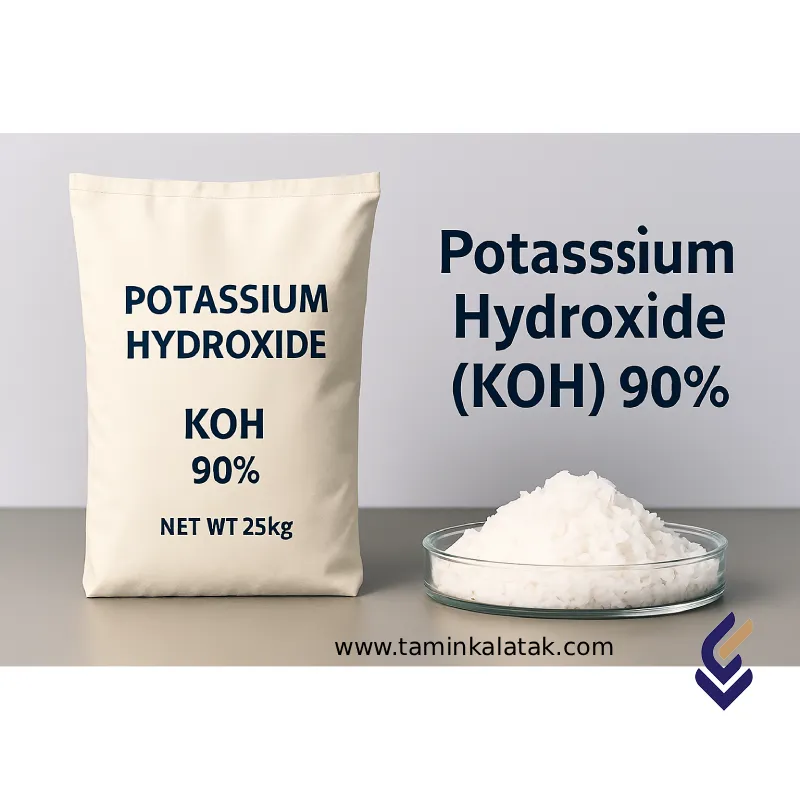potassium hydroxide 90%
Also known as Caustic Potash or Potash Lye, Potassium Hydroxide is a highly caustic and versatile inorganic base widely used across various industries.
It is available in different grades, most commonly as 90% solid (flakes or pellets) and 45% aqueous solution.
The solid 90% grade is a white, odorless, crystalline, and strongly hygroscopic material, utilized in applications ranging from battery production to agriculture and cleaning formulations.
Chemical Structure of Potassium Hydroxide (90%)
-
Chemical Name: Potassium Hydroxide
-
Chemical Formula: KOH
-
CAS Number: 1310-58-3
-
Structure Type: Ionic – composed of K⁺ and OH⁻ ions
-
Molecular Weight: 56.11 g/mol
-
Crystal Form: White, odorless, hygroscopic crystals (absorbs moisture and CO₂ from air)
-
EC Number: 215-181-3
Physical and Chemical Properties
| Property | Description / Value |
|---|---|
| Physical State | Solid (Flakes / Pellets) – White |
| Purity | ≥ 90% (Industrial Grade) |
| Density (20°C) | 2.12 g/cm³ |
| Melting Point | 360°C (partial decomposition at higher temperatures) |
| Boiling Point | 1320°C (decomposes before complete vaporization) |
| pH (1% solution, 25°C) | 13.5 – 14 |
| Solubility in Water (20°C) | ~1100 g/L – Highly exothermic dissolution |
| Reaction with Water | Strongly exothermic |
| Solubility in Ethanol | High (unlike NaOH) |
| Vapor Pressure | Zero (non-volatile) |
Applications
1. Detergent and Cleaning Industry
-
Used in the manufacture of liquid dishwashing detergents and potassium-based soaps.
-
Serves as a milder alternative to Sodium Hydroxide (NaOH) in specific cleaning formulations.
2. Food Industry (E525 – Food Grade)
-
Employed as a pH regulator and food additive under code E525.
-
Used for softening olives, preparing alkaline beverages, and food processing under controlled conditions.
3. Chemical Industry
-
Raw material for potassium compound synthesis, including K₂CO₃, K₃PO₄, and other derivatives.
-
Applied in the production of alkaline batteries and chemical intermediates.
4. Agriculture
-
Used in alkaline nutrient solutions, fertilizer production, and pest control formulations.
-
Provides an available source of potassium for specialized agrochemical formulations.
5. Metallurgy and Battery Manufacturing
-
Functions as an electrolyte in Nickel-Cadmium (Ni-Cd) and Nickel-Metal Hydride (Ni-MH) batteries.
-
Acts as a metal surface cleaner and desulfurization agent.
Advantages
✅ Stronger base compared to Sodium Hydroxide in certain reactions
✅ Rapid and complete solubility in water and alcohol
✅ Ideal for processes requiring potassium ions (K⁺)
✅ Convenient to handle, transport, and store in solid form
Limitations
⚠️ Higher cost compared to NaOH
⚠️ Highly corrosive to skin, eyes, and light metals
⚠️ Strongly hygroscopic – requires moisture-proof packaging and dry storage
⚠️ Exothermic reaction with water – may cause splashing and thermal burns
Safety and Handling
-
GHS Classification: H314 – Causes severe skin burns and serious eye damage (Skin Corr. 1A)
-
Required PPE: Chemical-resistant gloves, safety goggles, face shield, and dust mask
-
Skin/Eye Contact: Rinse immediately with plenty of cold water for at least 15 minutes and seek medical attention
-
Reaction with Water: Highly exothermic – risk of splashing or sudden boiling
-
Storage Conditions: Store in a dry, cool, and well-ventilated area away from moisture and CO₂ exposure
-
Packaging Options: 25 kg laminated bags, sealed HDPE drums, or metal containers
-
Chemical Incompatibilities: Strong acids, light metals (e.g., aluminum, zinc), and chlorinated organic compounds
Summary
Potassium Hydroxide (KOH) is an essential alkaline compound used in numerous industrial sectors such as detergents, batteries, fertilizers, food processing, and chemical synthesis.
Its strong basicity, high solubility, and chemical reactivity make it a critical raw material in both industrial and laboratory-scale processes.
Applications
| Applications | , , , , |
|---|
potassium hydroxide 90%
| Solubility in water | Melting point | Density (at 20°C) | Physical appearance | Vapor pressure | Grade | Products |
|---|---|---|---|---|---|---|
| ~1100 g/L (very high, exothermic reaction) | 360°C | 2.12 g/cm³ | White solid, odorless, in flake or pellet form, absorbent of moisture and CO₂ | Zero (non-volatile) | Industrial Grade (90% Flake / Pellet), Solution Grade (45%), Food Grade (E525) | Potassium Hydroxide |







